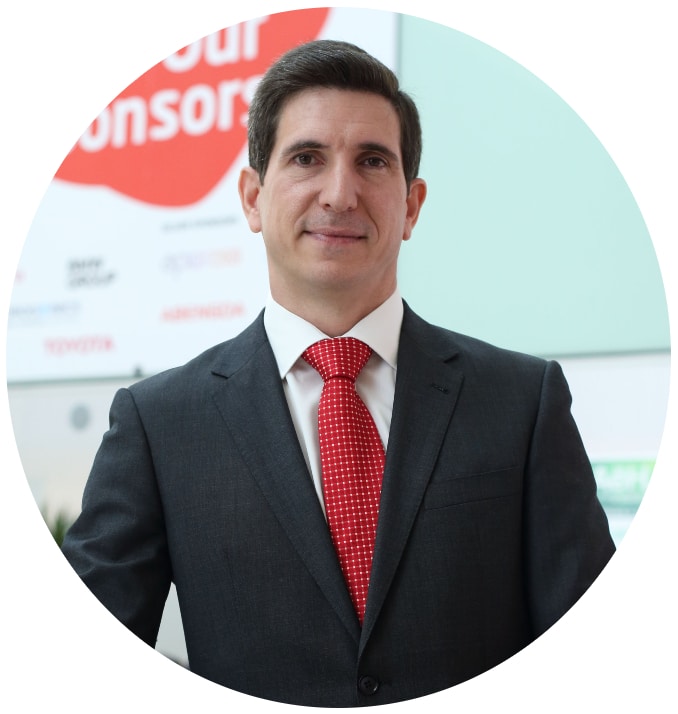Julia Maria Gomez de Avila Segade | 24/02/2023
The aerospace industry’s alliance with hydrogen goes back decades and still has significant growth potential. We analyze with Javier Brey, Chairman of the Spanish Hydrogen Association, this shared and undiscovered journey.
Hydrogen has been widely employed in the space industry since the international space race of the 1960s. This liquid-state energy vector has already been used in missions as relevant as those that made up the historic Apollo program. “This hydrogen was combined with liquid oxygen to provide enough thrust to the rockets. That is why we can say that thanks to hydrogen as a fuel, man was able to reach the moon,” said Javier Brey, Chairman of the Spanish Hydrogen Association (AeH2).
In space launches, the first thrust is made with fossil fuels. Once that phase is overcome, hydrogen is used. This synergy between industries initially arose because of the qualities of hydrogen, which could be refueled quickly and weighed very little due to its composition. Moreover, today we know another important advantage: when combined with oxygen, the only residue is water vapor.
Challenges and limitations
Hydrogen also has characteristics that can limit its potential use in the transportation industry. “The problem with liquid hydrogen is that, if it is not kept very cold (-253°C), it tends to evaporate. It tends to turn into a gaseous state and evaporate. Keeping it liquid means keeping it at 253 degrees below zero, which means we have to use it quickly. This was not a problem in rockets, because they had an ephemeral use, but for ground applications and vehicles, compressed hydrogen is usually used, which can remain stored for long periods of time,” assures Javier Brey.
Although the idea of creating up to three hydrogen-powered aircraft prototypes by 2035 is already on the table, there is another limitation to this development: the size of the aircraft. “Hydrogen, even when liquid, takes up more than fossil fuel, currently used by aircraft. That leads us to think about more efficient ways of using it, or even other aircraft configurations,” assures the expert. These new models could reverse their distribution, shifting passengers to the wings, and placing the bulk of the fuel in the center of the fuselage. “In fact, one of the prototypes presented by Airbus is a kind of delta wing, with a triangular shape,” he notes.
Subject of the research
In addition to its historical role in propulsion, hydrogen projects are being carried out to stabilize space stations and vehicles. Fuel cells, using oxygen and hydrogen, allow the space crew to have access to the water, heat and electricity needed to stay in orbit. “In fact, the famous phrase “Houston, we have a problem” arose because they were failing to supply oxygen to the Apollo fuel cell, which was providing the electricity,” Brey recalls. Along the same lines, we can find electrolyzers that are already used, for example, on the International Space Station (ISS) or on NASA’s Perseverance Rover, which landed on Mars in 2021.
“We have developed aeronautical technology,
and we also have an enormous opportunity to transfer these advances
that have been made in the space field to the civil industry”
Although it already plays a significant role in the space race, the Chairman of the Spanish Hydrogen Association insists that the potential of hydrogen is enormous. “Fuel cells make it possible to transform hydrogen and oxygen into water, and electrical and thermal energy, and electrolyzers, electrical energy and water into oxygen and hydrogen. All this makes it an enormously flexible energy vector, closely linked to two fundamental resources in space, namely water and oxygen,” he says. This progress is also being made at Spanish technology centers such as INTA, CSIC and Ciemat.
“We have developed aeronautical technology, and we also have an enormous opportunity to transfer these advances that have been made in the space field to the civil industry, because one of the greatest challenges we face is production at scale. That is, to manufacture increasingly more electrolyzer systems, fuel cells, tanks, hydrogen, compressors, etc., in order to reduce costs and make these technologies more and more common and ensure that we use them in our day-to-day lives”, he says.
As explained by the Association, we are referring to a transversal solution for all means of transportation. There are already companies that manufacture and market vehicles, it is used in high-speed trains and also in the shipbuilding industry. “The benefits of using renewable hydrogen are clear: it is a clean fuel that does not emit CO2 neither when produced nor when consumed, it is enormously versatile, we can produce it locally, and it is a fundamental tool for decarbonizing strategic sectors”, insists its Chairman.
The roadmap for the hydrogen industry to build on is based on three pillars:
-
- Producing more and more, having hydrogen plants that allow us to have this fuel in adequate quality and quantity.
- Creating the necessary support infrastructure, such as pipelines or service stations.
- Investing in and strengthening R&D centers to continue to be technology leaders and to transfer technology to companies.
As Javier Brey reiterates, hydrogen is not exclusive to companies of a certain size or in certain sectors, but is becoming increasingly integrated into the market. “We are experiencing a key turning point. We are transforming what were intentions, ideas, and forecasts into tangible projects, into realities, into demonstrating that hydrogen really is a great opportunity for everyone”, he concludes.
Professional profile… 
Javier Brey has an Engineering degree from the University of Seville, and a Doctorate from the Pablo de Olavide University in Seville; he studied for his doctoral thesis on Hydrogen Economy.
In 1998, he began his professional career in the field of hydrogen and fuel cells at the company Abengoa. In 2016, he left Abengoa to create and direct H2B2, a tech company focused on clean hydrogen production through polymer electrolysis.
He is the Chairman of the Spanish Hydrogen Association (AeH2), Vice Chairman of the Spanish Fuel Cell Association (Appice), and secretary of the Spanish Technology Platform for Hydrogen (PTE-H2 [Plataforma Tecnológica Española del Hidrógeno]). He is also a professor at Loyola University.
Keep reading… Innovation and sustainability: how to reduce emissions in aviation





